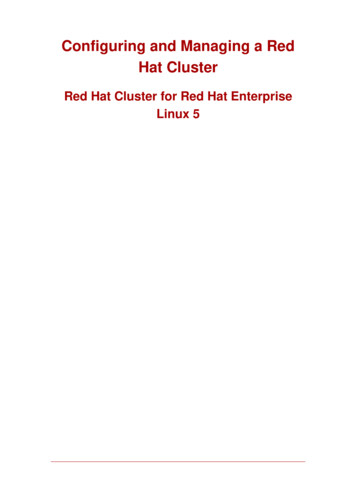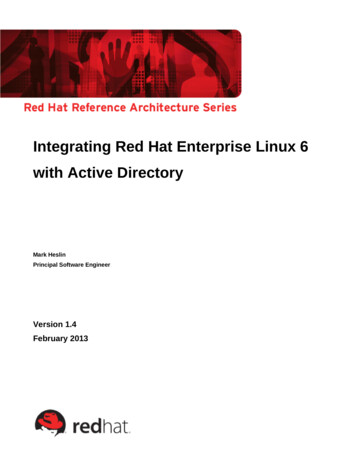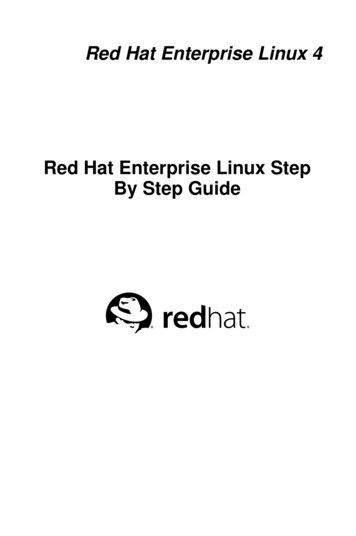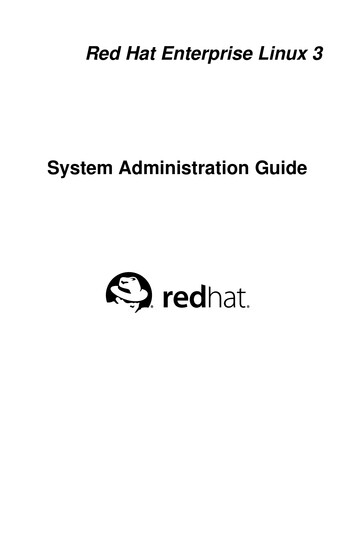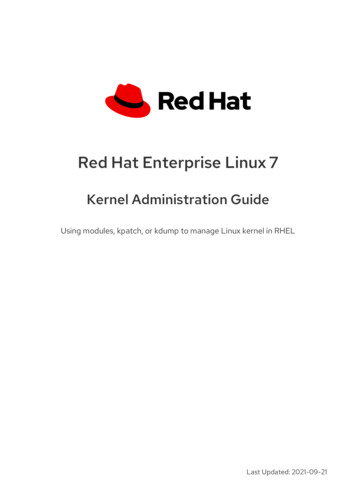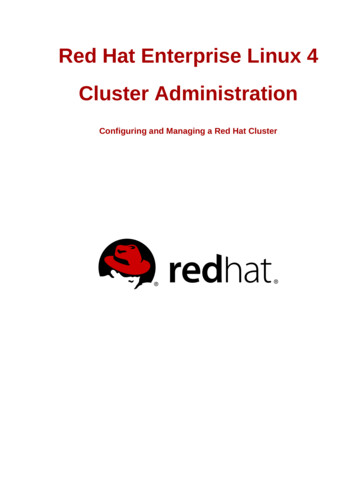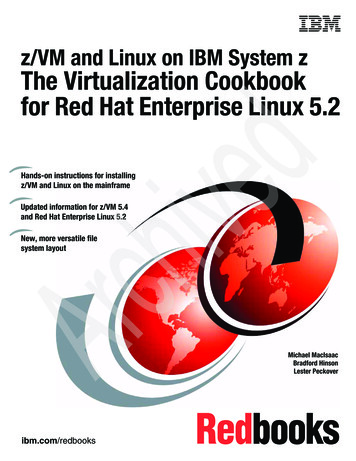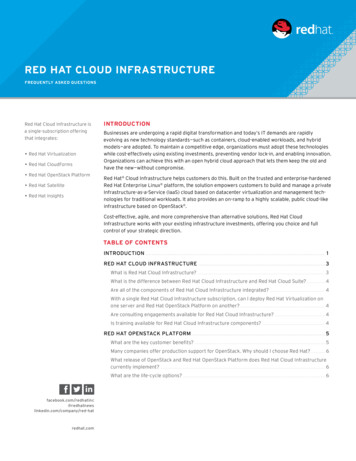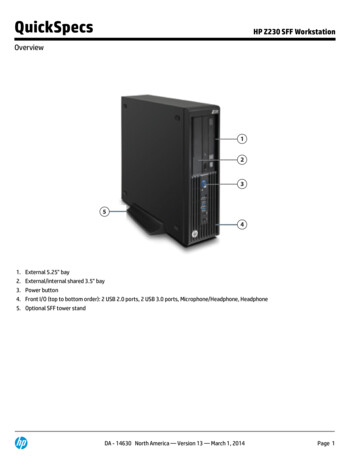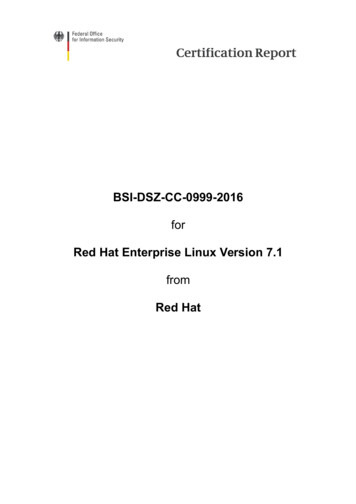
Transcription
BSI-DSZ-CC-0999-2016forRed Hat Enterprise Linux Version 7.1fromRed Hat
BSI - Bundesamt für Sicherheit in der Informationstechnik, Postfach 20 03 63, D-53133 BonnPhone 49 (0)228 99 9582-0, Fax 49 (0)228 9582-5477, Infoline 49 (0)228 99 9582-111Certification Report V1.0CC-Zert-327 V5.14
BSI-DSZ-CC-0999-2016 (*)Operating SystemRed Hat Enterprise LinuxVersion 7.1fromRed HatPP Conformance:Operating System Protection Profile, Version 2.0, 01June 2010, BSI-CC-PP-0067-2010,OSPP Extended Package – AdvancedManagement, Version 2.0, 28 May 2010,OSPP Extended Package – Labeled Security,Version 2.0, 28 May 2010Functionality:PP conformant plus product specific extensionsCommon Criteria Part 2 extendedAssurance:Common Criteria Part 3 conformantEAL 4 augmented by ALC FLR.3The IT Product identified in this certificate has been evaluated at an approved evaluationfacility using the Common Methodology for IT Security Evaluation (CEM), Version 3.1extended by Scheme Interpretations for conformance to the Common Criteria for ITSecurity Evaluation (CC), Version 3.1. CC and CEM are also published as ISO/IEC 15408and ISO/IEC 18045.(*) This certificate applies only to the specific version and release of the product in itsevaluated configuration and in conjunction with the complete Certification Report andNotification. For details on the validity see Certification Report part A chapter 4The evaluation has been conducted in accordance with the provisions of the certificationscheme of the German Federal Office for Information Security (BSI) and the conclusionsof the evaluation facility in the evaluation technical report are consistent with theevidence adduced.This certificate is not an endorsement of the IT Product by the Federal Office forInformation Security or any other organisation that recognises or gives effect to thiscertificate, and no warranty of the IT Product by the Federal Office for InformationSecurity or any other organisation that recognises or gives effect to this certificate, iseither expressed or implied.SOGISRecognition AgreementCommon CriteriaRecognition ArrangementBonn, 26 September 2016For the Federal Office for Information SecurityBernd KowalskiHead of DepartmentL.S.Bundesamt für Sicherheit in der InformationstechnikGodesberger Allee 185-189 - D-53175 Bonn -Postfach 20 03 63 - D-53133 BonnPhone 49 (0)228 99 9582-0 - Fax 49 (0)228 9582-5477 - Infoline 49 (0)228 99 9582-111
Certification ReportBSI-DSZ-CC-0999-2016This page is intentionally left blank.4 / 50
BSI-DSZ-CC-0999-2016Certification ReportPreliminary RemarksUnder the BSIG1 Act, the Federal Office for Information Security (BSI) has the task ofissuing certificates for information technology products.Certification of a product is carried out on the instigation of the vendor or a distributor,hereinafter called the sponsor.A part of the procedure is the technical examination (evaluation) of the product accordingto the security criteria published by the BSI or generally recognised security criteria.The evaluation is normally carried out by an evaluation facility recognised by the BSI or byBSI itself.The result of the certification procedure is the present Certification Report. This reportcontains among others the certificate (summarised assessment) and the detailedCertification Results.The Certification Results contain the technical description of the security functionality ofthe certified product, the details of the evaluation (strength and weaknesses) andinstructions for the user.1Act on the Federal Office for Information Security (BSI-Gesetz - BSIG) of 14 August 2009,Bundesgesetzblatt I p. 28215 / 50
Certification ReportBSI-DSZ-CC-0999-2016ContentsA. Certification.71. Specifications of the Certification Procedure.72. Recognition Agreements.73. Performance of Evaluation and Certification.94. Validity of the Certification Result.95. Publication.10B. Certification Results.111. Executive Summary.122. Identification of the TOE.143. Security Policy.194. Assumptions and Clarification of Scope.205. Architectural Information.206. Documentation.217. IT Product Testing.218. Evaluated Configuration.239. Results of the Evaluation.2410. Obligations and Notes for the Usage of the TOE.3711. Security Target.3812. Definitions.3813. Bibliography.40C. Excerpts from the Criteria.41CC Part 1:.41CC Part 3:.42D. Annexes.496 / 50
s of the Certification ProcedureCertification ReportThe certification body conducts the procedure according to the criteria laid down in thefollowing: Act on the Federal Office for Information Security2 BSI Certification and Approval Ordinance3 BSI Schedule of Costs4 Special decrees issued by the Bundesministerium des Innern (Federal Ministry of theInterior) DIN EN ISO/IEC 17065 standard BSI certification: Scheme documentation describing the certification process(CC-Produkte) [3] BSI certification: Scheme documentation on requirements for the Evaluation Facility, itsapproval and licencing process (CC-Stellen) [3] Common Criteria for IT Security Evaluation (CC), Version 3.1 5 [1] also published asISO/IEC 15408. Common Methodology for IT Security Evaluation (CEM), Version 3.1 [2] also publishedas ISO/IEC 18045. BSI certification: Application Notes and Interpretation of the Scheme (AIS) [4]2.Recognition AgreementsIn order to avoid multiple certification of the same product in different countries a mutualrecognition of IT security certificates - as far as such certificates are based on ITSEC orCC - under certain conditions was agreed.2.1.European Recognition of ITSEC/CC – Certificates (SOGIS-MRA)The SOGIS-Mutual Recognition Agreement (SOGIS-MRA) Version 3 became effective inApril 2010. It defines the recognition of certificates for IT-Products at a basic recognitionlevel and, in addition, at higher recognition levels for IT-Products related to certain SOGISTechnical Domains only.2Act on the Federal Office for Information Security (BSI-Gesetz - BSIG) of 14 August 2009,Bundesgesetzblatt I p. 28213Ordinance on the Procedure for Issuance of Security Certificates and approval by the Federal Office forInformation Security (BSI-Zertifizierungs- und -Anerkennungsverordnung - BSIZertV) of 17 December2014, Bundesgesetzblatt 2014, part I, no. 61, p. 22314Schedule of Cost for Official Procedures of the Bundesamt für Sicherheit in der Informationstechnik(BSI-Kostenverordnung, BSI-KostV) of 03 March 2005, Bundesgesetzblatt I p. 5195Proclamation of the Bundesministerium des Innern of 12 February 2007 in the Bundesanzeiger dated23 February 2007, p. 37307 / 50
Certification ReportBSI-DSZ-CC-0999-2016The basic recognition level includes Common Criteria (CC) Evaluation Assurance LevelsEAL 1 to EAL 4 and ITSEC Evaluation Assurance Levels E1 to E3 (basic). For"Smartcards and similar devices" a SOGIS Technical Domain is in place. For "HW Deviceswith Security Boxes" a SOGIS Technical Domains is in place, too. In addition, certificatesissued for Protection Profiles based on Common Criteria are part of the recognitionagreement.The new agreement has been signed by the national bodies of Austria, Finland, France,Germany, Italy, The Netherlands, Norway, Spain, Sweden and the United Kingdom. Thecurrent list of signatory nations and approved certification schemes, details on recognition,and the history of the agreement can be seen on the website at https://www.sogisportal.eu.The SOGIS-MRA logo printed on the certificate indicates that it is recognised under theterms of this agreement by the nations listed above.This certificate is recognized under SOGIS-MRA for all assurance components selected.2.2.International Recognition of CC – Certificates (CCRA)The international arrangement on the mutual recognition of certificates based on the CC(Common Criteria Recognition Arrangement, CCRA-2014) has been ratified on 08September 2014. It covers CC certificates based on collaborative Protection Profiles (cPP)(exact use), CC certificates based on assurance components up to and including EAL 2 orthe assurance family Flaw Remediation (ALC FLR) and CC certificates for ProtectionProfiles and for collaborative Protection Profiles (cPP).The CCRA-2014 replaces the old CCRA signed in May 2000 (CCRA-2000). Certificatesbased on CCRA-2000, issued before 08 September 2014 are still under recognitionaccording to the rules of CCRA-2000. For on 08 September 2014 ongoing certificationprocedures and for Assurance Continuity (maintenance and re-certification) of oldcertificates a transition period on the recognition of certificates according to the rules ofCCRA-2000 (i.e. assurance components up to and including EAL 4 or the assurancefamily Flaw Remediation (ALC FLR)) is defined until 08 September 2017.As of September 2014 the signatories of the new CCRA-2014 are governmentrepresentatives from the following nations: Australia, Austria, Canada, Czech Republic,Denmark, Finland, France, Germany, Greece, Hungary, India, Israel, Italy, Japan,Malaysia, The Netherlands, New Zealand, Norway, Pakistan, Republic of Korea,Singapore, Spain, Sweden, Turkey, United Kingdom, and the United States.The current list of signatory nations and approved certification schemes can be seen onthe website: http://www.commoncriteriaportal.org.The Common Criteria Recognition Arrangement logo printed on the certificate indicatesthat this certification is recognised under the terms of this agreement by the nations listedabove.As this certificate is a re-certification of a certificate issued according to CCRA-2000 thiscertificate is recognized according to the rules of CCRA-2000, i.e. for all assurancecomponents selected.8 / 50
BSI-DSZ-CC-0999-20163.Certification ReportPerformance of Evaluation and CertificationThe certification body monitors each individual evaluation to ensure a uniform procedure, auniform interpretation of the criteria and uniform ratings.The product Red Hat Enterprise Linux, Version 7.1 has undergone the certificationprocedure at BSI. This is a re-certification based on BSI-DSZ-CC-0754-2012. Specificresults from the evaluation process BSI-DSZ-CC-0754-2012 were re-used.The evaluation of the product Red Hat Enterprise Linux, Version 7.1 was conducted byatsec information security GmbH. The evaluation was completed on 30 June 2016. atsecinformation security GmbH is an evaluation facility (ITSEF) 6 recognised by the certificationbody of BSI.For this certification procedure the sponsor and applicant is: Red Hat.The product was developed by: Red Hat.The certification is concluded with the comparability check and the production of thisCertification Report. This work was completed by the BSI.4.Validity of the Certification ResultThis Certification Report only applies to the version of the product as indicated. Theconfirmed assurance package is only valid on the condition that all stipulations regarding generation, configuration and operation, as given in thefollowing report, are observed, the product is operated in the environment described, as specified in the following reportand in the Security Target.For the meaning of the assurance levels please refer to the excerpts from the criteria atthe end of the Certification Report or in the CC itself.The Certificate issued confirms the assurance of the product claimed in the Security Targetat the date of certification. As attack methods evolve over time, the resistance of thecertified version of the product against new attack methods needs to be re-assessed.Therefore, the sponsor should apply for the certified product being monitored within theassurance continuity program of the BSI Certification Scheme (e.g. by a re-certification).Specifically, if results of the certification are used in subsequent evaluation and certificationprocedures, in a system integration process or if a user's risk management needs regularlyupdated results, it is recommended to perform a re-assessment on a regular e.g. annualbasis.In order to avoid an indefinite usage of the certificate when evolved attack methods requirea re-assessment of the products resistance to state of the art attack methods, themaximum validity of the certificate has been limited. The certificate issued on 26September 2016 is valid until 25 September 2021. Validity can be re-newed byre-certification.The owner of the certificate is obliged:1. when advertising the certificate or the fact of the product's certification, to refer tothe Certification Report as well as to provide the Certification Report, the Security6Information Technology Security Evaluation Facility9 / 50
Certification ReportBSI-DSZ-CC-0999-2016Target and user guidance documentation mentioned herein to any customer of theproduct for the application and usage of the certified product,2. to inform the Certification Body at BSI immediately about vulnerabilities of theproduct that have been identified by the developer or any third party after issuanceof the certificate,3. to inform the Certification Body at BSI immediately in the case that security relevantchanges in the evaluated life cycle, e.g. related to development and production sitesor processes, occur, or the confidentiality of documentation and information relatedto the Target of Evaluation (TOE) or resulting from the evaluation and certificationprocedure where the certification of the product has assumed this confidentialitybeing maintained, is not given any longer. In particular, prior to the dissemination ofconfidential documentation and information related to the TOE or resulting from theevaluation and certification procedure that do not belong to the deliverablesaccording to the Certification Report part B, or for those where no disseminationrules have been agreed on, to third parties, the Certification Body at BSI has to beinformed.In case of changes to the certified version of the product, the validity can be extended tothe new versions and releases, provided the sponsor applies for assurance continuity (i.e.re-certification or maintenance) of the modified product, in accordance with the proceduralrequirements, and the evaluation does not reveal any security deficiencies.5.PublicationThe product Red Hat Enterprise Linux, Version 7.1 has been included in the BSI list ofcertified products, which is published regularly (see also Internet: https://www.bsi.bund.deand [5]). Further information can be obtained from BSI-Infoline 49 228 9582-111.Further copies of this Certification Report can be requested from the developer 7 of theproduct. The Certification Report may also be obtained in electronic form at the internetaddress stated above.7Red Hat100 East Davie StreetRaleigh, NC 27601USA10 / 50
BSI-DSZ-CC-0999-2016B.Certification ReportCertification ResultsThe following results represent a summary of the Security Target of the sponsor for the Target of Evaluation, the relevant evaluation results from the evaluation facility, and complementary notes and stipulations of the certification body.11 / 50
Certification Report1.BSI-DSZ-CC-0999-2016Executive SummaryThe Target of Evaluation (TOE) is Red Hat Enterprise Linux, Version 7.1.Red Hat Enterprise Linux is a highly-configurable Linux-based operating system which hasbeen developed to provide a good level of security as required in commercialenvironments. It also meets all requirements of the Operating System protection profile[OSPP]. Additional functionality to the OSPP base is claimed: Advanced Management (MLS mode only) Labeled Security (MLS mode only) Runtime protection against programming errors Packet Filter Linux Container Framework Support (not on POWER architecture)The TOE can operate in two different modes of operation called “Base mode” and “MLSmode”. In Base mode, the SELinux security module does not enforce a mandatory accesscontrol policy for the general computing environment and does not recognize sensitivitylabels of subjects and objects. SELinux can either be disabled completely, or enabled witha non-MLS policy which only add additional restrictions to the base access controlfunctions without interfering with the “root” administrator role. In this mode the TOEenforces all security requirements of the OSPP [8].SELinux must be enabled if the administrator wants to provide virtual machines. In MLSmode, the SELinux security module is configured to enforce the mandatory access controlpolicy based on the labels of subjects and objects as required by the extended OSPPpackages for labeled security [8] as well as advanced management [8].The Security Target [6] is the basis for this certification. It is based on the certifiedProtection Profile and Extended PackagesOperating System Protection Profile, Version 2.0, 01 June 2010, BSI-CC-PP-0067-2010,OSPP Extended Package – Advanced Management, Version 2.0, 28 May 2010,OSPP Extended Package – Labeled Security, Version 2.0, 28 May 2010 [8].The TOE Security Assurance Requirements (SAR) are based entirely on the assurancecomponents defined in Part 3 of the Common Criteria (see part C or [1], Part 3 for details).The TOE meets the assurance requirements of the Evaluation Assurance Level EAL 4augmented by ALC FLR.3.The TOE Security Functional Requirements (SFR) relevant for the TOE are outlined in theSecurity Target [6], chapter 6.3. They are selected from Common Criteria Part 2 and someof them are newly defined. Thus the TOE is CC Part 2 extended.The TOE Security Functional Requirements are implemented by the following TOESecurity Functionality:TOE Security FunctionalityAddressed issueAuditingThe Lightweight Audit Framework (LAF) is designed to be an auditsystem making Linux compliant with the requirements from CommonCriteria. LAF is able to intercept all system calls as well as retrievingaudit log entries from privileged user space applications. The subsystem12 / 50
BSI-DSZ-CC-0999-2016TOE Security FunctionalityCertification ReportAddressed issueallows configuring the events to be actually audited from the set of allevents that are possible to be audited.Cryptographic supportThe TOE provides cryptographically secured communication channelsas well as cryptographic primitives that unprivileged users can utilize forunspecified purposes. The TOE provides cryptographically securedcommunication to allow remote entities to log into the TOE. Forinteractive usage, the SSHv2 protocol is provided. Using OpenSSH,password-based and public-key-based authentication are allowed.Packet filterThe TOE provides a stateless and stateful packet filter for regularIP-based communication. OSI Layer 3 (IP) and OSI layer 4 (TCP, UDP,ICMP) network protocols can be controlled using this packet filter. Toallow virtual machines to communicate with the environment, the TOEprovides a bridging functionality. Ethernet frames routed through bridgesare controlled by a separate packet filter which implements a statelesspacket filter for the TCP/IP protocol family.Identification andAuthenticationUser identification and authentication in the TOE includes all forms ofinteractive login (e.g. using the SSH protocol or log in at the localconsole) as well as identity changes through the su or sudo command.These all rely on explicit authentication information provided interactivelyby a user.Discretionary Access Control(DAC)DAC allows owners of named objects to control the access permissionsto these objects. These owners can permit or deny access for otherusers based on the configured permission settings. The DACmechanism is also used to ensure that untrusted users cannot tamperwith the TOE mechanisms.Mandatory Access Control(MAC)The TOE supports mandatory access control.Security ManagementThe security management facilities provided by the TOE are usable byauthorized users and/or authorized administrators to modify theconfiguration of TSF.Runtime ProtectionMechanismsThe TOE provides mechanisms to prevent or significantly increase thecomplexity of an exploitation of common buffer overflow and similarattacks. These mechanisms are used for the TSF and are available tountrusted code.Linux Container FrameworkSupport (not on POWERarchitecture)Linux Containers provide execution environments for processes. TheseLinux Containers isolate the processes, ensure resource accounting andlimitation as well as Linux kernel service limitation.Table 1: TOE Security FunctionalitiesFor more details please refer to the Security Target [6], chapter 7.3.The assets to be protected by the TOE are defined in the Security Target [6], chapter 3.1.1.Based on these assets the TOE Security Problem is defined in terms of Assumptions,Threats and Organisational Security Policies. This is outlined in the Security Target [6],chapter 3.This certification covers the configurations of the TOE as outlined in chapter 8.The vulnerability assessment results as stated within this certificate do not include a ratingfor those cryptographic algorithms and their implementation suitable for encryption anddecryption (see BSIG Section 9, Para. 4, Clause 2).The certification results only apply to the version of the product indicated in the certificateand on the condition that all the stipulations are kept as detailed in this Certification13 / 50
Certification ReportBSI-DSZ-CC-0999-2016Report. This certificate is not an endorsement of the IT product by the Federal Office forInformation Security (BSI) or any other organisation that recognises or gives effect to thiscertificate, and no warranty of the IT product by BSI or any other organisation thatrecognises or gives effect to this certificate, is either expressed or implied.2.Identification of the TOEThe Target of Evaluation (TOE) is called:Red Hat Enterprise Linux, Version 7.1The following table outlines the TOE deliverables:No TypeIdentifierRelease1SWRed Hat Enterprise Linux 7.1 Server, x86 64 Architecture7.1rhel-server-7.1-x86 64-dvd.iso SHA-256 44c3c2ee1520f4f661c15ceDownload2SWRed Hat Enterprise Linux 7.1 Server, ppc64 Architecture7.1rhel-server-7.1-ppc64-dvd.iso SHA-256 32158e6bef50b13d7ed3f79Download3SWRed Hat Enterprise Linux 7.1 Server, ppc64le Architecturerhel-server-7.1-ppc64le-dvd.iso SHA-256 926840365b0769894460fa17.1Download4SWRed Hat Enterprise Linux 7.1 Server, s390x Architecture7.1rhel-server-7.1-s390x-dvd.iso SHA-256 030c5587764e9caa7fedfe9Download5SW /DOCEvaluation package RPM EAL4 RHEL7.1, including the"Evaluated Configuration Guide" ([10])cc-config-rhel71-*.rpmDownload7.1Form ofDelivery14 / 50
BSI-DSZ-CC-0999-2016Certification ReportNo TypeIdentifierReleaseForm ofDelivery6Additional RPMs for x86 64seepackagenamesDownloadSW(x86 64)bind-libs-9.9.4-18.el7 1.2.x86 64.rpm, bind-libs-lite-9.9.4-18.el7 1.2.x86 64.rpm,bind-license-9.9.4-18.el7 1.2.noarch.rpm, bind-utils-9.9.4-18.el7 1.2.x86 64.rpm,binutils-2.23.52.0.1-30.el7 1.2.x86 64.rpm,ca-certificates-2015.2.4-70.0.el7 1.noarch.rpm, cups-1.6.3-17.el7 1.1.x86 64.rpm,cups-client-1.6.3-17.el7 1.1.x86 64.rpm,cups-filesystem-1.6.3-17.el7 1.1.noarch.rpm,cups-libs-1.6.3-17.el7 1.1.x86 64.rpm,device-mapper-1.02.93-3.el7 1.1.x86 64.rpm,device-mapper-event-1.02.93-3.el7 1.1.x86 64.rpm,device-mapper-event-libs-1.02.93-3.el7 1.1.x86 64.rpm,device-mapper-libs-1.02.93-3.el7 1.1.x86 64.rpm,lvm2-2.02.115-3.el7 1.1.x86 64.rpm, lvm2-libs-2.02.115-3.el7 1.1.x86 64.rpm,dnsmasq-2.66-13.el7 1.x86 64.rpm, dracut-033-241.el7 1.5.x86 64.rpm,dracut-config-rescue-033-241.el7 1.5.x86 64.rpm,dracut-network-033-241.el7 1.5.x86 64.rpm,freetype-2.4.11-10.el7 1.1.x86 64.rpm, glibc-2.17-79.el7 1.4.x86 64.rpm,glibc-common-2.17-79.el7 1.4.x86 64.rpm, gnutls-3.3.8-12.el7 1.1.x86 64.rpm,hwdata-0.252-7.8.el7 1.x86 64.rpm, iputils-20121221-6.el7 1.1.x86 64.rpm,kernel-3.10.0-229.26.2.el7.x86 64.rpm,kernel-headers-3.10.0-229.26.2.el7.x86 64.rpm,kernel-tools-3.10.0-229.26.2.el7.x86 64.rpm,kernel-tools-libs-3.10.0-229.26.2.el7.x86 64.rpm,kexec-tools-2.0.7-19.el7 1.2.x86 64.rpm, libgcrypt-1.5.3-12.el7 1.1.x86 64.rpm,libpcap-1.5.3-4.el7 1.2.x86 64.rpm, libreswan-3.12-10.1.el7 1.x86 64.rpm,libuser-0.60-7.el7 1.x86 64.rpm, libxml2-2.9.1-5.el7 1.2.x86 64.rpm,libxml2-python-2.9.1-5.el7 1.2.x86 64.rpm, nspr-4.10.8-2.el7 1.x86 64.rpm,nss-3.19.1-5.el7 1.x86 64.rpm, nss-sysinit-3.19.1-5.el7 1.x86 64.rpm,nss-tools-3.19.1-5.el7 1.x86 64.rpm, nss-util-3.19.1-5.el7 1.x86 64.rpm,nss-softokn-3.16.2.3-13.el7 1.x86 64.rpm,nss-softokn-freebl-3.16.2.3-13.el7 1.x86 64.rpm,openssh-6.6.1p1-12.el7 1.x86 64.rpm,openssh-clients-6.6.1p1-12.el7 1.x86 64.rpm,openssh-keycat-6.6.1p1-12.el7 1.x86 64.rpm,openssh-server-6.6.1p1-12.el7 1.x86 64.rpm,openssl-1.0.1e-42.el7 1.9.x86 64.rpm, openssl-libs-1.0.1e-42.el7 1.9.x86 64.rpm,python-2.7.5-18.el7 1.1.x86 64.rpm, python-libs-2.7.5-18.el7 1.1.x86 64.rpm,samba-libs-4.1.12-23.el7 1.x86 64.rpm, libwbclient-4.1.12-23.el7 1.x86 64.rpm,selinux-policy-3.13.1-23.el7 1.8.noarch.rpm,selinux-policy-devel-3.13.1-23.el7 1.8.noarch.rpm,selinux-policy-mls-3.13.1-23.el7 l7 1.8.noarch.rpm,libipa hbac-1.12.2-58.el7 1.14.x86 64.rpm,libsss idmap-1.12.2-58.el7 1.14.x86 64.rpm,libsss nss idmap-1.12.2-58.el7 1.14.x86 64.rpm,sssd-client-1.12.2-58.el7 1.14.x86 64.rpm,sssd-common-1.12.2-58.el7 1.14.x86 64.rpm,sssd-common-pac-1.12.2-58.el7 1.14.x86 64.rpm,sssd-ipa-1.12.2-58.el7 1.14.x86 64.rpm,sssd-krb5-common-1.12.2-58.el7 1.14.x86 64.rpm,systemd-208-20.el7 1.5.x86 64.rpm, systemd-libs-208-20.el7 1.5.x86 64.rpm,systemd-sysv-208-20.el7 1.5.x86 64.rpm, libgudev1-208-20.el7 1.5.x86 64.rpm,trousers-0.3.11.2-4.el7 1.x86 64.rpm, .el7 1.x86 64.rpm, libblkid-2.23.2-22.el7 1.x86 64.rpm,libmount-2.23.2-22.el7 1.x86 64.rpm, libuuid-2.23.2-22.el7 1.x86 64.rpm,wpa supplicant-2.0-17.el7 1.x86 64.rpm, dracut-fips-033-241.el7 1.3.x86 64.rpm,dracut-fips-aesni-033-241.el7 1.3.x86 64.rpm15 / 50
Certification ReportBSI-DSZ-CC-0999-2016No TypeIdentifierReleaseForm ofDelivery7Additional RPMs for .4-18.el7 1.2.s390x.rpm, bind-libs-lite-9.9.4-18.el7 1.2.s390x.rpm,bind-license-9.9.4-18.el7 1.2.noarch.rpm, bind-utils-9.9.4-18.el7 1.2.s390x.rpm,binutils-2.23.52.0.1-30.el7 1.2.s390x.rpm,ca-certificates-2015.2.4-70.0.el7 1.noarch.rpm, cups-1.6.3-17.el7 1.1.s390x.rpm,cups-client-1.6.3-17.el7 1.1.s390x.rpm,cups-filesystem-1.6.3-17.el7 1.1.noarch.rpm, cups-libs-1.6.3-17.el7 1.1.s390x.rpm,device-mapper-1.02.93-3.el7 1.1.s390x.rpm,device-mapper-event-1.02.93-3.el7 l7 1.1.s390x.rpm,device-mapper-libs-1.02.93-3.el7 1.1.s390x.rpm,lvm2-2.02.115-3.el7 1.1.s390x.rpm, lvm2-libs-2.02.115-3.el7 1.1.s390x.rpm,dnsmasq-2.66-13.el7 1.s390x.rpm, dracut-033-241.el7 1.5.s390x.rpm,dracut-config-rescue-033-241.el7 1.5.s390x.rpm,dracut-network-033-241.el7 1.5.s390x.rpm, freetype-2.4.11-10.el7 1.1.s390x.rpm,glibc-2.17-79.el7 1.4.s390x.rpm, glibc-common-2.17-79.el7 1.4.s390x.rpm,gnutls-3.3.8-12.el7 1.1.s390x.rpm, hwdata-0.252-7.8.el7 1.s390x.rpm,iputils-20121221-6.el7 1.1.s390x.rpm, 19.el7 1.2.s390x.rpm, libgcrypt-1.5.3-12.el7 1.1.s390x.rpm,libpcap-1.5.3-4.el7 1.2.s390x.rpm, libreswan-3.12-10.1.el7 1.s390x.rpm,libuser-0.60-7.el7 1.s390x.rpm, libxml2-2.9.1-5.el7 1.2.s390x.rpm,libxml2-python-2.9.1-5.el7 1.2.s390x.rpm, nspr-4.10.8-2.el7 1.s390x.rpm,nss-3.19.1-5.el7 1.s390x.rpm, nss-sysinit-3.19.1-5.el7 1.s390x.rpm,nss-tools-3.19.1-5.el7 1.s390x.rpm, nss-util-3.19.1-5.el7 1.s390x.rpm,nss-softokn-3.16.2.3-13.el7 1.s39
OSPP Extended Package - Advanced Management, Version 2.0, 28 May 2010, . certificate, and no warranty of the IT Product by the Federal Office for Information . . The CCRA-2014 replaces the old CCRA signed in May 2000 (CCRA-2000). Certificates based on CCRA-2000, issued before 08 September 2014 are still under recognition .
